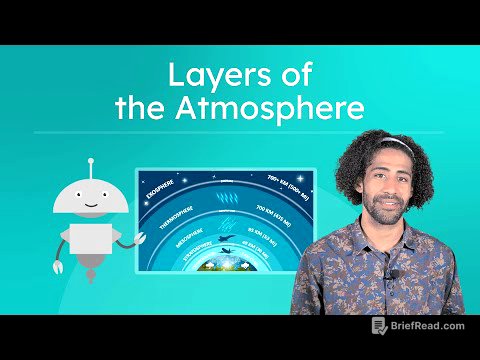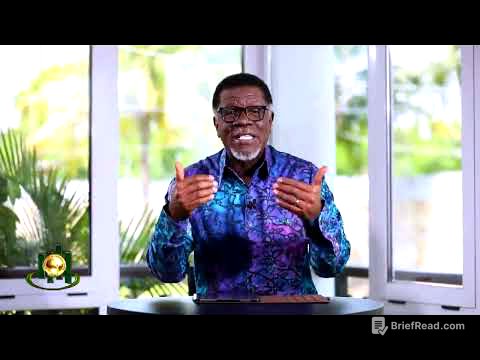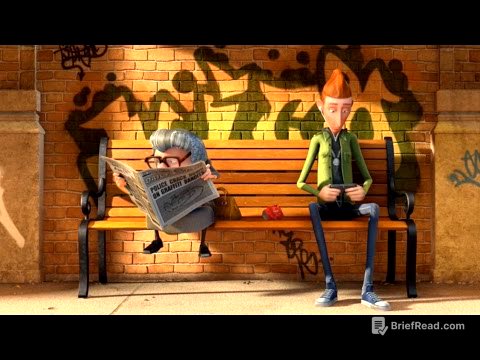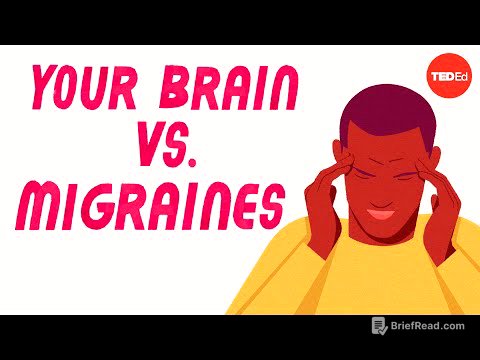TLDR;
This video provides a comprehensive review of 100 frequently repeated questions in Bihar Police exams, focusing on general knowledge, science, and history. It emphasizes memorization of key facts and concepts, offering additional insights and related information to enhance understanding and recall.
- Nuclear energy and isotopes
- Civil Disobedience Movement and related historical events
- Important geographical facts
- Biology and human body facts
Intro [0:00]
The video is an important resource for those preparing for Bihar Police exams, focusing on frequently repeated questions. The instructor emphasizes memorizing direct questions and answers, as these are commonly repeated in exams. The session aims to provide a "panacea" for exam takers by covering essential topics and facts.
Trending GK and GS Questions [1:14]
The session will cover trending GK and GS questions, similar to those taught in Bindu GS Academy's paid courses. The instructor notes that the material was previously incomplete in other videos due to its length, but this session aims to provide a more detailed explanation.
Nuclear Energy and Isotopes [2:52]
Uranium 235 is used to generate electricity in nuclear power plants. Iodine 131 is used for thyroid gland diagnosis and treatment. Cobalt 60 is used in cancer treatment. Arsenic 74 detects tumors, Sodium 24 detects blood clots, and Phosphorus 32 is used to treat leukemia. Isotopes are atoms with the same atomic number but different mass numbers, while isobars have the same mass number but different atomic numbers. India's first nuclear power plant is located in Tarapur, Maharashtra. Other nuclear plants are in Narora (UP), Rawat Bhata (Rajasthan), Kudankulam and Kalpakkam (Tamil Nadu), and Kakrapar (Gujarat).
Civil Disobedience Movement [7:02]
The Civil Disobedience Movement started with the Dandi March in 1930, which began on March 12 and lasted until April 6, 1930. The march covered 240 miles (385 kilometers) with 78 followers. The Lahore session of 1929 demanded complete independence, presided over by Pandit Jawaharlal Nehru. The first Round Table Conference was in 1930, the second in 1931 (attended by Gandhiji), and the third in 1932. The Ahmedabad Mill Movement and Kheda Satyagraha both occurred in 1918, while the Non-cooperation movement started in 1920, and the Champaran Satyagraha in 1917. The Quit India Movement took place in 1942.
Non-Aligned Movement and Bahadur Shah Zafar [10:20]
The first summit of the Non-Aligned Movement was held in Belgrade in 1961, founded by Jawaharlal Nehru, Abdul Nasir, and Broz Tito. After the 1857 revolt, Bahadur Shah Zafar was exiled to Rangoon. Bahadur Shah Zafar was the last Mughal emperor, and he led the revolt of 1857 from Delhi with Bakht Khan. The 1857 Revolution started on May 10, 1857, in Meerut, with Mangal Pandey as a key figure from the Bengal Native Infantry.
Leaders of the 1857 Revolution and Biodiversity [12:50]
Veer Kunwar Singh led the 1857 revolution in Bihar, Rani Lakshmibai led in Jhansi, Begum Hazrat Mahal in Lucknow, Nana Saheb and Tatya Tope in Kanpur, and Ahmadullah Shah in Faizabad. The term "biodiversity" was coined by Walter Rosen. Biodiversity Day is celebrated on May 22. India has four biodiversity hotspots: Western Ghats, Himalayas, Sundaland, and the Indo-Burma region, with the Western Ghats having the highest biodiversity.
Constituent Assembly [15:10]
The first session of the Constituent Assembly was held under the temporary chairmanship of Sachchidanand Sinha, with Dr. Rajendra Prasad later becoming the permanent president. The first meeting of the Constituent Assembly was on December 9, 1946, and the constitution was adopted on November 26, 1949, taking 2 years, 11 months, and 18 days to draft. Constitution Day is celebrated on November 26, which is also National Milk Day. The idea of the Constituent Assembly was first proposed by MN Roy, while B N Rao was the constitutional advisor. The last meeting of the Constituent Assembly was on January 24, 1950, and it came into force on January 26, 1950. Jawaharlal Nehru was India's first and longest-serving Prime Minister, and the author of "Discovery of India." Dr. Rajendra Prasad was India's first and longest-serving President, born in Siwan, Bihar. Sardar Vallabhbhai Patel, known as the Bismarck of India, led the Bardauli Satyagraha in 1928 and was given the title Sardar by the women of Bardauli.
Eye Anatomy and Civil Services Questions [21:14]
The iris controls the amount of light entering the eye. The cornea is used in eye donations, and images are formed on the retina, which creates real, inverted, and smaller reflections.
Winds and Their Circulation Areas [22:19]
The circulation areas of winds are: Boro in Italy, Mistral in southern France, Khamsin in Egypt, and Harmattan in western Africa.
Agriculture and Rocket Science [23:54]
In Chhattisgarh, shifting agriculture is called Deepak; in Manipur, it is called Pamalu; and in Assam, it is called Jhum. In Bihar, shifting agriculture is known as Kuruba, while Bebar and Dahiya are terms used in Madhya Pradesh. Rocket propulsion is based on the principle of conservation of momentum and Newton's third law of motion.
Light, Property Rights, and Fundamental Rights [27:46]
When light passes from a denser to a rarer medium, it moves away from the normal. The right to property is now a legal right under Article 300A, having been removed from fundamental rights by the 44th constitutional amendment in 1978. Fundamental Rights are in Part III, Articles 12 to 35, taken from the American constitution. Article 14 provides equality before the law, Article 15 prohibits discrimination, Article 16 ensures equality of opportunity in public employment, Article 17 abolishes untouchability, and Article 18 abolishes titles. Article 19 guarantees freedom of speech and expression, Article 20 protects against conviction, Article 21 ensures life and bodily liberty, and Article 22 protects against arrests in some cases. Article 23 prohibits human trafficking and child labor, Article 24 restricts employing children under 14 in factories, and Article 25 guarantees freedom of religion. Article 29 protects the interests of minorities, and Article 30 provides the right to establish educational institutions for minorities. Article 32, called the heart and soul of the constitution by Dr. Bhimrao Ambedkar, provides the right to constitutional remedies, under which the Supreme Court issues writs. Article 33 grants Parliament the power to abolish the fundamental rights of the armed forces, and Article 34 addresses actions taken to maintain order during martial law.
Cell Structure and Raja Rammohan Roy [31:28]
The correct order of biological organization is cells, tissues, organs, and organ systems. Raja Rammohan Roy founded Atmiya Sabha in 1815 and the Brahmin society in 1828. He also wrote the book "Samvad Komodi." Saraswati Dayanand Saraswati established Arya Samaj in 1875, Jyotiba Phule founded the Satyashodhak Samaj, and Swami Vivekananda founded the Ramakrishna Mission.
Blood Flow and Atmospheric Layers [32:53]
The reverse flow of blood towards the heart occurs in veins. Radio communication is facilitated by the ionosphere. The atmosphere is divided into five layers: troposphere, stratosphere, mesosphere, ionosphere, and exosphere. The troposphere is the lowest layer where weather events occur, the stratosphere contains the ozone layer and is where jet planes fly, and TV and radio communication is possible through the ionosphere.
Moti Masjid and Food Chains [33:58]
Aurangzeb built the Moti Masjid in Delhi's Red Fort, while Shah Jahan built the Moti Masjid in Agra Fort. Shah Jahan also constructed the Jama Masjid in Delhi, while Jahan Ara Begum constructed the Jama Masjid in Agra. Akbar constructed the Red Fort of Agra, while Shah Jahan built the Red Fort in Delhi. A correct food chain is plant, grasshopper, bird.
Global Warming and Voter Ink [36:36]
Carbon dioxide is the gas most responsible for global warming, comprising 0.03% of the atmosphere and used to extinguish fires. Solid carbon dioxide is known as dry ice. Oxygen was discovered by Joseph Crystal, and nitrogen is the most abundant gas in the atmosphere at 78%, with oxygen at 21%. Voters use ink containing silver nitrate.
Constitutional Amendments and Indus Valley Civilization [38:13]
Article 368 of the Indian Constitution relates to constitutional amendments, originating from South Africa and located in Part 20. Evidence of ploughed fields from the Indus Valley Civilization was found in Kalibanga, Rajasthan, while evidence of an ancient port was found in Lothal, Gujarat. Dholavira, Gujarat, is the 40th World Heritage Site in India, and remains of horse bones were found in Surkotada, Gujarat.
Light Dispersion and AIDS [39:37]
When white light passes through a glass prism, purple light deviates the most, while red light deviates the least. AIDS is a viral disease discovered by Ivano Vaski, and the ELISA test is used for its diagnosis. World AIDS Day is celebrated on December 1.
Rajya Sabha and Five-Year Plans [42:02]
The allocation of seats in the Rajya Sabha is in the fourth schedule of the Indian Constitution. The first schedule covers the Union and its territories, the second covers salaries, the third covers oaths, the fifth covers SC/ST reservations, the sixth covers SC/ST administration in Assam, Meghalaya, Tripura, and Mizoram, the seventh divides power between the center and state, and the eighth mentions 22 languages. The ninth schedule covers land reforms, the tenth covers defection, the eleventh covers Panchayat, and the twelfth covers municipalities. The 11th Five Year Plan aimed at rapid, more inclusive, and sustainable growth. The first Five Year Plan focused on agricultural development, the second on industrial development, and the third on an independent economy. The first Five Year Plan was based on the Harrod-Domar model, and the second on the PC Malnovis model. The planning holiday was from 1966 to 1969.
Milk Sugar and Buddhist Councils [45:06]
Milk sugar is called lactose, and lactic acid is found in sour milk or curd. The four Buddhist Councils took place in Rajgir, Vaishali, Pataliputra, and Kashmir (Kundalvan) in chronological order. The first Buddhist Council in Rajgir occurred during the reign of Ajatashatru, the second in Vaishali during the reign of Kalashoka, the third in Pataliputra during the reign of Ashoka, and the fourth in Kashmir during the reign of Kanishka.
Writs and Eskimo Tribes [46:26]
A prohibition writ can only be issued against judicial and quasi-judicial bodies. There are five types of writs, issued by the Supreme Court under Article 32 and by the High Court under Article 226. Habeas corpus ensures personal freedom within 24 hours. The Eskimo tribe resides in North America.
National Parks and the Battle of Plassey [47:33]
Bhitarak Kanika National Park is famous for turtles and is located in Orissa, as is Simlipal National Park. Gir National Park in Gujarat is famous for Asiatic lions, Periyar National Park in Kerala is famous for elephants, and Kaziranga National Park in Assam is famous for one-horned rhinoceroses. After the Battle of Plassey in 1757, Mir Jafar became the Nawab of Bengal. The battle took place between Robert Clive and Siraj-ud-Daula.
Postal Amendment Bill and Mountain Ranges [48:50]
Giani Jail Singh used pocket veto on the Postal Amendment Bill. Neelam Sanjiva Reddy was the first President elected unopposed, and Dr. Rajendra Prasad was India's first President. The Aravalli mountain range is India's oldest, with its highest peak being Guru Shikhar.
Rivers and Rajya Sabha Elections [51:51]
Rivers flowing westward into the Arabian Sea include Sabarmati, Luni, Mahi, Narmada, and Tapti. Rivers flowing eastward into the Bay of Bengal include Godavari, Damodar, Mahanadi, Krishna, and Kaveri. The minimum age required for Rajya Sabha elections is 30 years.
Kalinga War and William Bentinck [56:16]
The Kalinga War is described in the 13th inscription of Ashoka. A Doordarshan serial was made based on Pandit Jawaharlal Nehru's "Discovery of India." William Bentinck did not implement the end of the story, which was done by Lord Alan Borough.
Presidential Elections and Planets [57:11]
Presidential elections consist of elected members of Parliament (Lok Sabha and Rajya Sabha) and Legislative Assemblies. Mars is approximately similar to Earth in size and mass and is called the red planet. The Gandhi Sagar Dam is part of the Chambal project.
Plant Groups and Digestive Systems [57:52]
Bryophyta and Pteridophyta have both sporophytes and zygophyte metastages that are multicellular and free-living. Digestive juices make complex substances simple, not the other way around. The stomach releases acid, the small intestine absorbs digested food into blood vessels, the large intestine absorbs water, and the liver is the largest gland in the body.
White Blood Cells and Plasma Membrane [59:40]
White blood cells (WBC) destroy germs and provide immunity. The plasma membrane is made of proteins and lipids.
Mitochondria and Oxygen Transport [1:00:11]
Mitochondria are the powerhouses of the cell, have a double membrane, contain DNA and ribosomes, and synthesize some of their proteins. Most oxygen (O2) is transported by red blood cells (RBC).
Blood Cells and Fatigue [1:01:07]
Erythrocyte is another name for red blood cells (RBC). The main cause of fatigue is the accumulation of lactic acid in muscles.
Blood Storage and Blood Groups [1:02:19]
Excess blood is stored in the spleen (Piha). People with blood group AB have antigens A and B but no antibodies and are omnipresent.
Bones and Cell Theory [1:03:45]
The malleus bone is located in the middle ear, and the smallest bone in the body is the stapes bone, also in the ear. The basic unit of life is the cell. The cell theory was proposed by Sliden, Snan, and Rudolf Virchow.
Acids and Tuberculosis Immunization [1:04:25]
Tomatoes contain citric acid, malic acid, ascorbic acid, and oxalic acid, but not formic acid. Formic acid is found in ant and scorpion stings. Seeds contain tartaric acid, and butter contains butyric acid. The BCG vaccine for tuberculosis immunization was developed by Albert Calmette and Camille Guerin.
Glands and Theophrastus [1:05:28]
Exocrine glands secrete products into carrier tubes. The pituitary gland maintains fluid balance and regulates the kidneys. Theophrastus is considered the father of botany.
Scientists and Binomial Nomenclature [1:06:21]
Birbal Sahni is related to fossil botany, KC Mehta to plant pathology, P Maheshwari to embryology, and M.S. Swaminathan to the Green Revolution. Carolus Linnaeus is considered the father of binomial nomenclature.
Organism Classification and Nitrogen Fixation [1:07:29]
Cavalier Smith classified organisms into six kingdoms. Blue-green algae are related to biological nitrogen fixation.
Bacterial Cells and Plant Functions [1:08:20]
The outermost layer of a bacterial cell envelope is called the glycocalyx. Thallophyta plants do not have differentiated functions.
Plant Structures and Hormones [1:08:54]
Rhodophyceae are red algae. Stomata facilitate transpiration, xylem transports water, phloem transports food, and root hairs absorb water. Auxins are growth hormones, gibberellin promotes cell growth, cytokinin promotes cell division, and abscisic acid inhibits growth.
Proteins and Liver Glands [1:15:10]
Proteins come from animal and plant sources and are made up of amino acids. Proteins constitute 15-20% of body weight and are building blocks for the body. The liver gland secretes bile, which is stored in the gall bladder.
Lungs and Immunity [1:17:24]
Air exhaled from human lungs contains 4.4% carbon dioxide. Lymphocytes are the most important cell type associated with the body's immunity.
Heart and Blood Vessels [1:18:06]
The heart acts like a pump, arteries carry oxygenated blood, and veins carry deoxygenated blood. Blood is red vascular connective tissue, constituting 7-8% of body weight, and red blood cells have a lifespan of 115-120 days.
Hormones and DNA [1:19:37]
Human growth hormones are secreted by the anterior lobe of the pituitary gland. Insulin is released from the beta cells of the islets of Langerhans in the pancreas, discovered by Betting and Best, and controls blood sugar levels. DNA is the genetic material of all living organisms, contains both coding and non-coding regions, has two antiparallel nucleotide chains in a double helix, and is also found in mitochondria.
Charles Darwin and Ruby Hail [1:22:00]
Charles Darwin's book "On the Origin of Species" is a landmark in the study of evolution, and he gave the theory of natural selection. Measles is also known as Ruby Hail.
Bacterial Diseases and Pairs [1:22:38]
Rabies is not a bacterial disease but is caused by a virus. Chloroquine is used in the treatment of malaria. Scurvy is caused by a deficiency of Vitamin C (ascorbic acid), and beriberi is caused by a deficiency of Vitamin B1 (thiamine).
Myopia and Bread Rising [1:23:37]
A concave lens is used to correct nearsightedness (myopia). Thousands of bubbles form when bread rises due to carbon dioxide.
Biofertilizers and Lunar Missions [1:25:04]
Blue-green algae are biofertilizers, Cryosopa is used for pest control, and Brio 902 is a Soma clone of mustard. Azotobacter acts as a biofertilizer, not a biopesticide. Chandrayaan-1, India's first lunar mission, was launched in 2008, Chandrayaan-2 in 2019, and Chandrayaan-3 in 2023, successfully landing on the South Pole on August 23, 2023. All three Chandrayaan missions were launched from Satish Dhawan Space Centre in Sriharikota, Andhra Pradesh. Mangalyaan was launched in 2013 from the same space center.
Nuclear Power Plants and Missiles [1:27:21]
There is no nuclear power plant in Vijayawada. Agni 5 is an Indian surface-to-surface missile.
Computer Devices and Memory Units [1:27:56]
A plotter, printer, and monitor are all output devices. 1 byte equals 8 bits, 1 kilobyte equals 1024 bytes, and 1 gigabyte equals 1024 megabytes. Memory units in ascending order are bit, byte, kilobyte, megabyte, gigabyte, terabyte, petabyte, exabyte, yottabyte.
Computer Shortcuts and Internet Protocols [1:31:14]
The keyboard shortcut to paste copied content in Windows is Ctrl+V. An IP address (Internet Protocol) is needed to connect to the internet.
Phishing and Conclusion [1:31:49]
Misrepresenting one's identity to obtain confidential information is called phishing. The video concludes with a promise to cover the remaining 100 questions in the next session and an invitation to attend the morning current affairs class.









